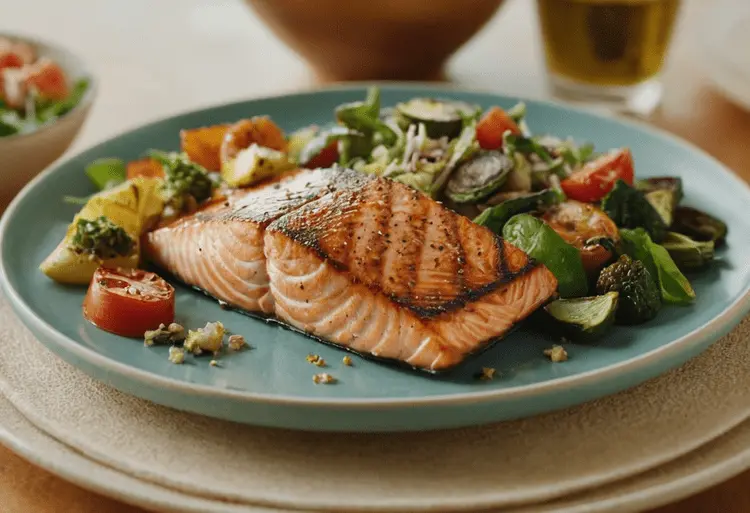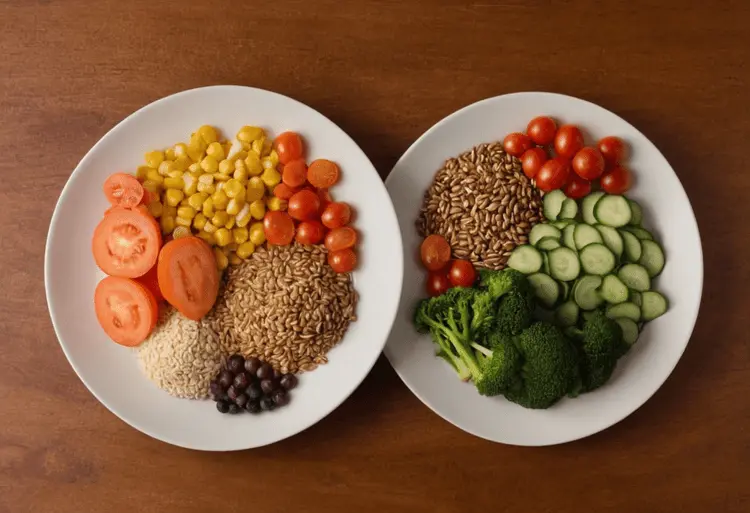Finding clear and practical diabetic diet tips can be a challenge. You might be wondering:
- Can I still enjoy delicious meals?
- Do I have to give up all my favorite foods?
- How can I manage my blood sugar effectively?
These questions can feel overwhelming, and conflicting advice makes it even harder to know where to start. Restrictive diets and bland meals don’t have to be your reality.
This post is here to help! We’ll provide you with smart diabetic diet tips, easy meal ideas, and valuable information for healthy eating with diabetes. You’ll learn how to create satisfying, blood-sugar-friendly meals that support your overall health.
Diabetic Diet Tips in a Nutshell
- Focus on quality carbs
- Embrace protein power
- Include healthy fats
- Prioritize fruits & veggies
- Plan your meals
- Personalize your approach
Table of contents
Introduction

Understanding Diabetes and Your Diet
Ever feel overwhelmed by all the information on managing diabetes? Trying to figure out what to eat can be especially confusing. But guess what? There’s good news! You can take charge of your health and enjoy delicious food with the right diabetic diet tips.
Let’s start with the basics. What is diabetes, exactly? It’s a condition where your body struggles to manage blood sugar (glucose) levels. And why does your diet matter? Because the foods you eat directly impact those blood sugar levels.
Debunking Diabetic Diet Myths
Think a diabetic diet means bland, boring food and zero desserts? Think again! A healthy and satisfying diet is absolutely possible with diabetes. Let’s bust some common myths:
- Myth: You can never have sugar again. While moderation is key, you can still enjoy occasional treats.
- Myth: Carbs are the enemy. The focus is on choosing healthy carbs and managing portions.
- Myth: Diabetic diets are one-size-fits-all. The best diet is tailored to your individual needs and preferences.
Ready to learn how to create a delicious and personalized eating plan? Let’s dive in! I’d love to hear YOUR biggest questions about diabetic diets – leave a comment below or tag me on social media!
Ready to ditch the boring broccoli and discover a world of delicious diabetic-friendly meals? Click here to unlock meal plans that will make your taste buds sing and your blood sugar happy!
The Core Components of a Diabetic-Friendly Diet
Carbohydrates: The Key to Blood Sugar Control
Think of carbohydrates as your body’s energy source. But for people with diabetes, managing carbs is essential! So, what does this mean for your diabetic diet tips?
- Focus on complex carbs: These are found in whole grains, legumes, and starchy vegetables. Your body breaks them down slowly, leading to steadier blood sugar levels.
- Minimize simple carbs: Think white bread, sugary drinks, and processed snacks. These spike your blood sugar fast!
- Understand the glycemic index (GI): This tool shows how different carbs affect your blood sugar. Choose more low-GI foods for better control.
- Fiber is your friend! Aim for fiber-rich carbs like beans, lentils, and whole-wheat bread. Fiber helps slow down digestion and keeps you feeling full.
Lean Proteins: Building Blocks for Good Health
Protein is key for building and repairing tissues – a must for good health, especially when managing diabetes. But what are the best choices?
- Prioritize lean protein sources: Opt for fish, poultry, beans, tofu, and low-fat dairy products.
- Control portion sizes: Even lean proteins need to be enjoyed in moderation. Stick to appropriate serving sizes for your needs.
Diabetic Diet Tips –The Power of Healthy Fats
Fat used to be the bad guy, but not anymore! Healthy fats are crucial for a diabetic-friendly diet. So what’s the deal with fats?
- Unsaturated fats are your friends: Think avocados, nuts, seeds, and olive oil. These help improve cholesterol levels and support heart health.
- Limit saturated and trans fats: These are found in fatty meats, processed foods, and some baked goods. They’re bad news for your health and can worsen blood sugar control.
Fruits and Vegetables: Nature’s Superfoods
Fruits and veggies are packed with essential nutrients and fiber! But is there a difference for people with diabetes? Absolutely.
- Non-starchy vegetables rule! Fill your plate with broccoli, spinach, carrots, and more. These have minimal impact on blood sugar.
- Enjoy fruit in moderation: While all fruits are healthy, choose lower-sugar options like berries and aim for appropriate portion sizes.
- Get creative: Find delicious ways to sneak more fruits and veggies into your diet – try smoothies, veggie-packed salads, or roasted veggie sides. Speaking of delicious, have you checked out these amazing diabetic-friendly recipes
Practical Strategies for Meal Planning and Eating

Diabetic Diet Tips –The Plate Method Made Easy
Ever feel lost when it comes to building a meal? The plate method can be your trusty guide! It’s a visual way to create balanced, diabetes-friendly meals that keep your blood sugar in check.
Here’s how it works:
- Picture a plate. Divide it in half.
- Fill half with colorful, non-starchy vegetables. Think broccoli, carrots, spinach, anything that grows above the ground!
- Dedicate one quarter to lean protein. Chicken, fish, beans, tofu – all great options.
- The final quarter is for carbs. Brown rice, whole-wheat pasta, sweet potatoes are fantastic choices.
Mastering Portion Control
Portion sizes can make or break your diabetic diet tips plan. Too much of even a healthy food can spike your blood sugar. But how do you know what’s right?
Here are a few tricks:
- Use your hand! A clenched fist equals about one cup of veggies or fruit. Your palm approximates a serving of protein.
- Invest in measuring cups and spoons.
- Visualize familiar objects. A serving of cooked oatmeal is about the size of a hockey puck.
Smart Snacking for Stable Blood Sugar
Snacking done right can prevent those dreaded blood sugar crashes. But what makes a smart diabetic snack?
The key is the combo:
- Protein: Keeps you feeling full.
- Healthy fats: Helps slow down carb digestion.
- Fiber: Adds to that feeling of fullness.
Here are some winning ideas:
- Greek yogurt with berries
- Handful of almonds and an apple
- Hard-boiled egg and whole-grain crackers
Diabetic Diet Tips –Grocery Shopping Success
The grocery store can be a field of temptation! Master the aisles with these diabetic diet tips:
- Focus on the perimeter. That’s where whole foods shine – fresh produce, lean meats, dairy.
- Read food labels like a pro. Pay attention to serving size, total carbohydrates, added sugars, and fiber.
- Have a healthy staples list. Stock up on brown rice, beans, canned tuna, whole-grain bread, and more.
Eating Out Confidently
Dining out doesn’t mean ditching your healthy habits. Is it possible to enjoy restaurant meals and manage blood sugar? Absolutely!
Remember these strategies:
- Preview menus online. Decide on your choices beforehand.
- Don’t hesitate to ask questions. What’s in the sauce? How is something prepared?
- Order dressings and sauces on the side.
- Share meals or take half home. Restaurant portions are often huge!
Let me know if you have any favorite diabetes-friendly restaurant hacks – tag me on social media!
Beyond Food: Lifestyle Factors for Optimal Blood Sugar
Food is vital for managing your diabetes, but did you know there’s more to the equation? Your lifestyle habits play a massive role in how well your body handles blood sugar. Let’s dive into those factors!
The Importance of Regular Exercise
Are you getting enough movement? Consistent exercise is like magic for people with diabetes. It improves your body’s ability to use insulin, the key hormone that regulates blood sugar.
- What type of exercise is best? Aim for a mix of cardio (like brisk walking or swimming) and strength training (like lifting weights).
- How much do you need? Strive for at least 150 minutes of moderate-intensity exercise per week.
Diabetic Diet Tips –Getting Quality Sleep
Sleep: it’s not just for feeling rested! When you’re sleep-deprived, your body produces stress hormones that can drive blood sugar levels up. Is lack of sleep sabotaging your diabetic diet tips efforts?
- How much sleep is enough? Most adults need around 7-8 hours per night.
- Struggling to fall asleep? Check out some relaxation techniques or talk to your doctor for help with sleep issues.
Manage Stress for Stable Blood Sugar
Feeling overwhelmed? Chronic stress wreaks havoc on your blood sugar. Your body dumps a surge of hormones designed to help you escape danger, but these hormones send blood sugar soaring.
- What relaxes you? Find healthy coping mechanisms for stress, like yoga, meditation, or spending time in nature.
- Can’t manage it alone? Consider speaking to a therapist who specializes in stress management or diabetes care.
The Emotional Side of Eating
Do you sometimes eat when you’re bored, sad, or anxious? Emotional eating can be a hidden obstacle for managing diabetes. Learning to eat mindfully, without judgment, can help you break free from unhelpful patterns.
- What triggers your emotional eating? Start by journaling and identifying any patterns.
- Need a healthier way to cope? Find alternative stress-reducing activities you enjoy (try exercise, art, or connecting with friends).
Let me know how these lifestyle factors are impacting your blood sugar management! Have you noticed a difference when you prioritize exercise or sleep? Share your thoughts in the comments or tag me on social media.
Your Path to Healthier Eating

This journey with diabetic diet tips isn’t about restrictions – it’s about finding freedom within a healthy, delicious way of eating. So, where do you begin?
Start with small changes. Swap sugary drinks for water, add a handful of veggies to your meals, or try a new diabetes-friendly recipe from a reliable source like EatingWell [invalid URL removed]. Every positive step counts!
Need more personalized support? Consider working with a Registered Dietitian (RD) or Certified Diabetes Care and Education Specialist (CDCES). These professionals can create a tailored plan and answer your specific questions about managing diabetes.
Remember, progress isn’t always linear. Some days will be easier than others. Be kind to yourself, and celebrate your successes along the way!
Let’s keep the conversation going! Did these diabetic diet tips help? What changes are you excited to try? I’d love to hear from you – comment below or tag me on social media!
Tired of feeling deprived on a diabetic diet? There’s a better way! Discover the naturally sweet and satisfying foods that can support your blood sugar goals. Get the inside scoop on the best foods for diabetics – click here!
FAQs – Your Diabetic Diet Questions Answered
Diabetics should limit sugary drinks, refined carbs, processed meats, fried foods, high-fat dairy, packaged sweets and snacks, trans fats, sweetened cereals, fruit in heavy syrup, and dried fruit with added sugar.
Diabetics can enjoy non-starchy vegetables, lean proteins, healthy fats, and unsweetened beverages like water and tea/coffee in moderation.
A good diabetic meal fills half the plate with non-starchy vegetables, a quarter with lean protein, and a quarter with whole grains or starchy vegetables.
No single food reduces diabetes, but a healthy overall diet pattern helps manage blood sugar and improve health outcomes.
No, the best diet is personalized to your preferences and needs.
No, focus on quality carbs from whole grains, fruits, and vegetables.
Absolutely! Explore flavorful recipes and ingredients for satisfying meals.
Plan ahead with healthy snacks like nuts, veggies, or fruit.
Yes! Ask for sauces on the side, smaller portions, or healthier substitutions.